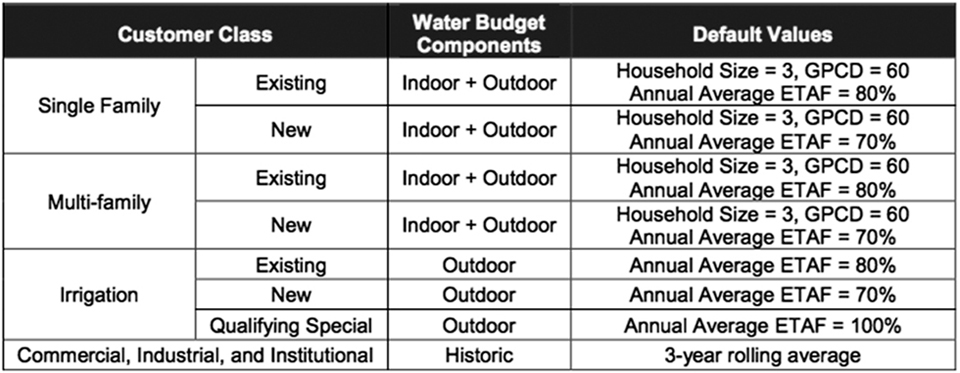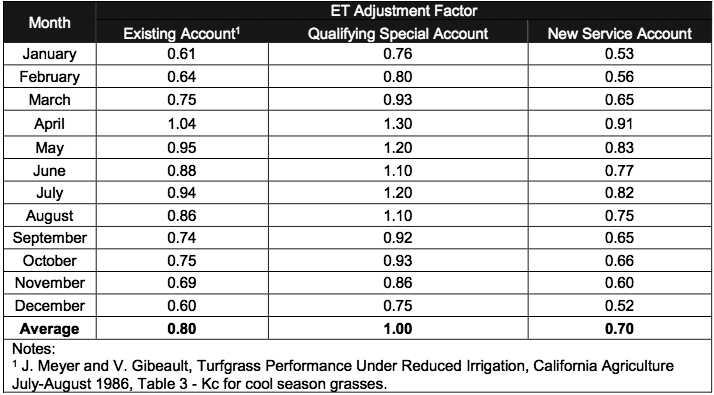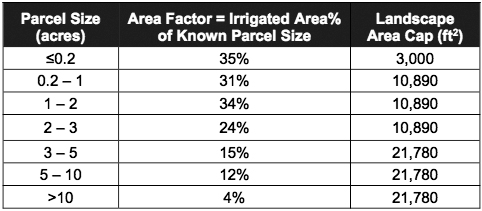Western Municipal Water District
Water Budget Summary
WMWD is a water district in Riverside County that includes a portion of the City of Riverside and several outlying areas. WMWD has about 23,000 retail customers and 8 wholesale customers. The annual retail demand is around 22,000 AF and the annual ET rate is about 56 inches.
WMWD implemented BBRs for all customers in October 2011 and has seen a 29% reduction in water use since water budgets were implemented. While the%age of customers meeting their budget generally varies by month, the yearly average has about 70% of customers meeting their individual budgets. Overall, BBRs have been an essential tool in reducing water use in WMWD’s service area. BBRs have also been essential in providing a fair and equitable way to ask customers to cut back during the drought. The rate structure allowed WMWD to reduce outdoor budgets by 30% during the drought and thus provide an economic incentive for customers to cut back.
To determine an efficient amount of water use, a water budget allocation must be calculated. The budget calculation has to account for the indoor, outdoor, and any business process needs of the individual customer. Although water budget allocations and tiered rate structures are designed individually for residential, irrigation, and commercial water service accounts in WMWD, there are many similarities among these unique customers.
Both single family and multi-family customers receive an indoor and outdoor water budget. Irrigation only (subset of commercial) accounts receive only an outdoor budget. The remaining commercial customers, along with industrial and institutional customers, including public authority customers, will have their water budgets based on historic rolling averages. The table below summarizes the water budget allocation by customer class and the following sections explain the data and equations that make up each water budget.

Residential Indoor Water Budget
The indoor water budget is determined by the customer’s household size and a standard consumption per person. WMWD’s indoor water budget formula is as follows:
Indoor Water Budget = GPCD Household Size Days DF + V
Where:
- GPCD – Gallons per capita per day. The standard consumption per person per day will be set at 60 gallons based on the AWWA Research Foundation Residential End Uses of Water, which stated that the mean daily water use per capita is 59.8 gallons, not including leaks. It should be noted that the Water Conservation Act of 2010 (SBx7-7) sets the efficient level of indoor residential water use at 55 gallon per person per day.
- Household Size – Number of residents. The default values for household size will be based on California Department of Finance Statistics for each customer class:
- Single Family: Household Size = 3 persons
- Multi-family: Household Size = 2 persons
- Days – the number of days of service varies with each billing cycle for each customer. The actual number of days of service will be applied to calculate the indoor water budget for each billing cycle.
- DFindoor – Indoor Drought Factor. This part of the budget equation will be used in extremely dry conditions only if needed because of local supply conditions or if required by regional and State agencies. A lower%age of the typical or usual indoor water budget may be allocated during extreme drought, supply shortage, or emergency conditions. Changing the drought factor will be subject to approval by the District’s Board of Directors. The indoor drought factor will be set at 100%, representing 100% water budget allotment, in times where no water shortage exists in the District’s service area.
- Vindoor – Indoor variance. A water allotment can be adjusted to fit the unique circumstances of any customer. Customers need to contact the District and/or complete an adjustment form and return to the District with necessary documentation.
- 748 – the conversion unit from gallons to billing unit of ccf
For illustrative purposes, the following indoor water budget calculations for two different customers are shown.
- Customer #1– Household Size = 4 persons, Days of Service in January bill = 30 days, no variance:
+ 0 ccf = 9.63 ccf
60 gallons
person 4 persons 30 days 100%
Indoor Water Budget = day
748 - Customer #2 – Household Size = 6 persons, Days of Service in January bill = 28 days, medical needs variance = 2 ccf per billing cycle
+ 2 ccf = 15.48 ccf
Indoor Water Budget = day
748
60 gallons
person 6 persons 28 days 100%
Outdoor Water Budget- Residential and Dedicated Irrigation (Commercial) Classes
The outdoor water budget is calculated using three components: irrigated landscape area, local weather data, and an efficiency adjustment factor. The irrigated landscape area is the square footage of landscape on a customer’s property, not necessarily the total property size. WMWD initially estimates customer square footage by using a%age of the total parcel size. The customer can then apply for a variance if the estimate was incorrect. The weather data is the daily reference ET. This measurement is published by universities, the agriculture industry, and public agencies such as the Department of Water Resources. In California, the reference plant material is cool-season tall fescue (the most typically planted lawn). The ET adjustment factor (ETAF) is a state legislated efficiency standard in the form of a coefficient that adjusts the water budget. The same allocation methodology and coefficient used by WMWD is also used in the California Model Water Efficient Landscape Ordinance (Assembly Bill 1881). Identical to state legislation, WMWD’s outdoor water budget accounts for the water needs of existing landscapes and accommodates both the stricter standards required of newly installed landscapes as well as the additional needs of school sites, public park recreational landscapes, and registered historic sites.
Following are annual average values for ETAF (also shown in the table below):
- New landscape water service: Annual Average ETAF new = 70%
- Existing landscape water service: Annual Average ETAF existing = 80%
- Special landscape water service6: Annual Average ETAF special = 100%
When WMWD implemented water budgets in 2011, existing customers were given an average ETAF of 80% of ET, while customers signing up for service after January 1, 2012 receive an average ETAF of 70% of ET. To address the seasonality of the growing cycle of plants, the District modifies the State’s efficiency coefficient and plant factor, and utilizes University of California, Riverside turf grass research to set more accurate plant coefficients per month. The table below shows ETAF by month and account type. Note the annual average ETAF values are consistent with Assembly Bill 1881.

The formula to calculate an outdoor water budget is as follows:
LA ET ETAF Outdoor Water Budget = ( 1200+ V ) DF
6 Based on CA Code of Regulation, Title 23, Chapter 2.7, Section 491, special landscape area is defined as an area of the landscape dedicated solely to edible plants, areas irrigated with recycled water, water features using recycled water, and areas dedicated to active play such as parks, sports fields, golf courses, and where turf provides a playing surface.
Where:
- d – number of days in the billing period
- ET0 – Actual ET. It is measured in inches of water during the billing period based on daily weather data acquired from HydroPoint Data Systems. WMWD’s service area has 455 individual weather microzones with each microzone a 0.6 mile (1 kilometer) square, as shown in the map . WMWD updates the actual ET for each microzone on a daily basis through a secure link to the HydroPoint FTP site. This allows weather changes to be accurately updated for every account in the District on a daily basis.
- ETAF – ET adjustment factor. It is defined using the Model Ordinance (Assembly Bill 1881) and the table shown above
- LA – Landscape Area, also referred to as Irrigated Landscape Area (in square feet). It is the measured irrigable landscape area served by a specific water meter. Customers are asked to return a “Water Budget Adjustment” form confirming their actual landscape area. Accurately accounting for landscape area for each customer is the desired objective. Accurate site measurement facilitates the most accurate water budget for each customer.
- DFoutdoor – Outdoor Drought Factor. This part of the budget equation is used in extremely dry conditions only if needed because of local supply conditions or if required by regional and State agencies. A lower%age of the typical or usual outdoor water budget may be allocated during extreme drought, supply shortage, or emergency conditions. Changing the drought factor will be subject to approval by the District’s Board of Directors. The outdoor drought factor will be set at 100%, representing 100% water budget allotment, in times where no water shortage exists in the District’s service area.
- Voutdoor – Outdoor variance. A water budget can be adjusted to fit the circumstances of any customer. Customers need to contact the District and/or complete an adjustment form and return to the District. The outdoor variance will be subject to the outdoor drought factor in extreme dry conditions.
- 1200 – the factor used to convert to billing units in ccf
- Customer #1 – Existing single family account, Landscape Area = 8,000 square feet, ET0 for 30- day January bill = 2.25 inches, ETAF for January = 0.61, no variance:
Outdoor Water Budget = 8,000 ft 2.25 inches 0.61 100% = 9.15 ccf 1200 - Customer #2 – Existing single family account, Landscape Area = 4,000 square feet, ET0 for 28- day January bill = 2.05 inches, ETAF for January = 0.61, variance = 1 ccf per billing cycle for approved special needs:
Outdoor Water Budget = 4,000 ft 2.05 inches 0.61 + 1 ccf 100% = 5.17 ccf 1200 - Area factor varies with parcel size as shown in the table below. The% of parcel size was calculated using historic water demand averages for all lots in the parcel size range.
- Large landscape area caps will be applied to all accounts with known parcel sizes larger than one- quarter acre as the default starting point. The landscape area caps varying with parcel sizes are also shown in the table below. If the actual irrigated area exceeds the applied cap, it will be the property owner’s or customer’s responsibility to provide updated information via an adjustment form.
- WMWD can only calculate the Landscape Area for the parcel in which the water meter is located. If the water meter serves more than one parcel (e.g., multi-family customers), it will be the property owner/customer responsibility to provide this information via an adjustment form.
- Usen – usage in the current billing period corresponds to usage in the same billing period for, at most, the previous 3 years
- Daysn – the number of days of service for the associated usage (i.e., number of days for each Usen)
- Days – the days of service in the current billing period
- Voutdoor – Historic variance. An adjustment to the water budget may be requested in order to change/update the average use and/or report a change in water needs for the business or institutional customer. Historic variance will be subject to the drought factor in extreme shortage conditions.
- DFhistoric – Historic Drought Factor. This part of the budget equation is used in extremely dry conditions only if needed because of local supply conditions or if required by regional and State agencies. A lower%age of the typical or usual outdoor water budget may be allocated during extreme drought, supply shortage, or emergency conditions. Changing the drought factor will be subject to approval by the District’s Board of Directors. The outdoor drought factor will be set at 100%, representing 100% water budget allotment, in times where no water shortage exists in the District’s service area.
- Customer #1 – Commercial A: Current bill (January 2011) = 30 days, January 2010 bill = 40 ccf for 35 days, January 2009 bill = 28 ccf for 30 days, January 2008 bill = 34 ccf for 32 days, no adjustment requested:
HistoricWaterBudget= 40+28+34ccf 30days+0ccf 100%=31.54ccf 35+30+32days - Customer #2 – Public Authority B: Current bill (January 2011) = 32 days, January 2010 bill = 140 ccf for 35 days, January 2009 bill = 182 ccf for 30 days, January 2008 bill = 134 ccf for 32 days, variance = 2 ccf per billing cycle for increase in employees over base years:
Historic Water Budget = 140 + 182 + 134 ccf 32 days + 2 ccf 100% = 152.43 ccf 35+30+32days
For illustrative purposes, the following outdoor water budget calculations for two different customers are shown.
Where the measured irrigable landscape area has not been provided or confirmed by the customer, the landscape area will be estimated using the following formula:
LA = Area Factor Parcel Size
Where:

Historic Water Budget- Commercial, Industrial, and Institutional Classes
The remaining classes, commercial (except dedicated irrigation), industrial and institutional (CII), are allocated water based on past historical billing period water use. The BBR structure and its individualized allocations recognize that business needs may vary dramatically depending on the type of business. For example, a car wash and an office building may contain the same number of employees, lot size, or even building footprint, but their water needs are quite different. WMWD calculates each individual billing period allocation based on a rolling 3-year billing period average use.
The formula to calculate a historic water budget is as follows:
Historic Water Budget = Use Days + V DF Days
Where:
For illustrative purposes, the following historical water budget calculations for two different customers are shown.
